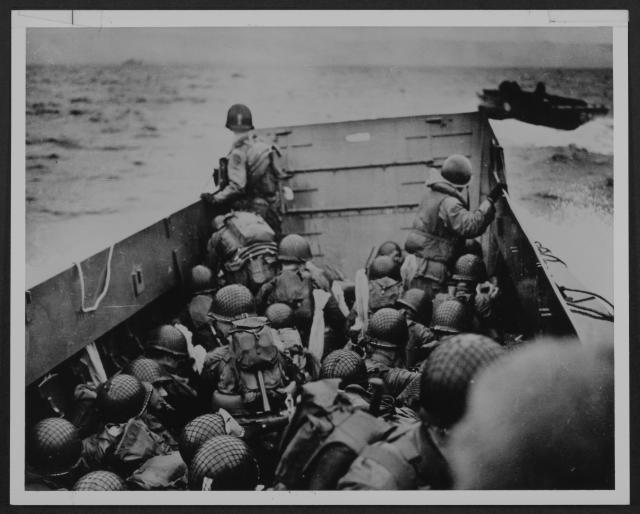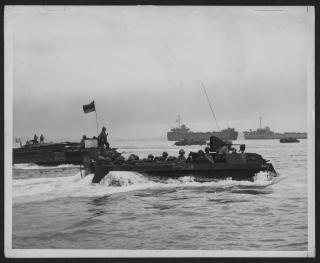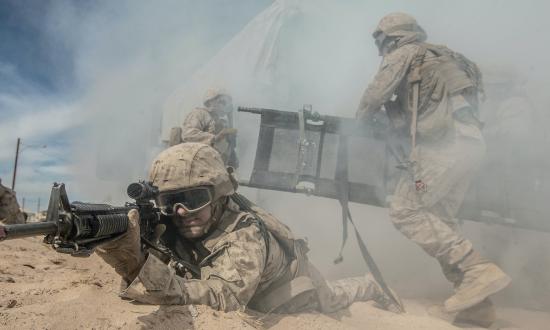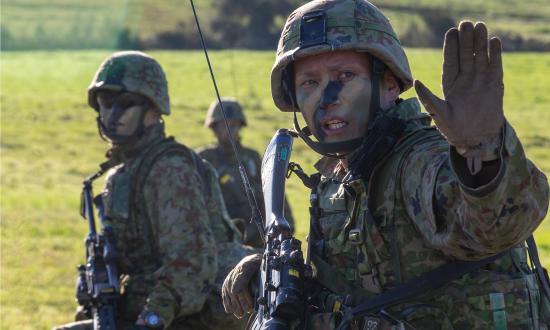It is disheartening to see influential pundits questioning the place of the Marine Corps in the nation’s defense, displaying the same old ignorance, spouting the same old untruths, and making the same tired arguments.
After World War II, despite the remarkable accomplishments of Marines in the Pacific, not to mention that the war in both hemispheres was dependent on amphibious assault warfare pioneered and institutionalized by the Navy–Marine Corps team, the chorus began about the unlikely need for amphibious landings in the future. Nuclear weapons were supposed to rule out the amassing of an invasion force. Talk of abolishing the Marine Corps was serious but did not prevail, perhaps because of the exceptional quality of Marine Corps leaders and public affection at the time.
The next big existential challenge came in the 1970s, when the focus of thought was on tank warfare in Europe and the Middle Eastern deserts. The argument again was heard that the Marine Corps’ specialty was obsolete and that the “lightness” of its amphibious forces was no match for enemy armies with heavy armored forces. Again, cooler heads prevailed.
While the American public appreciates the Marine Corps as an elite fighting force, and history proves it to be, the service’s greatest contribution to the nation’s defense is an institutional one. By its existence and that of the Navy’s amphibious fleet, and all the specialized machines and doctrinal systems that are integral to that, it ensures the United States will never be unable to affect a dynamic transition from fighting for control of the sea to fighting for control of the land beyond the sea, wherever need be, anywhere in the world. The Marine Corps was the first to do this, and the first to demonstrate that amphibious assault against determined opposition can succeed in modern warfare.
Indeed, in World War II, in both the Atlantic and the Pacific theaters, all U.S. ground forces initiated their contact with the enemy through fiercely opposed amphibious assault and were victorious in every instance.1 This would not have happened without the institution of the U.S. Marine Corps and a Navy that recognized the indispensable value of a formidable amphibious warfare capability and that built its fleets with that very much in mind.
Marines trained the Army forces that landed in North Africa in 1942 and later in Sicily, Italy, and Normandy, and those Army forces conformed fully with the naval doctrines of amphibious warfare and relied on the ships and equipment the Navy–Marine Corps team had optimized for that specialized mission prior to the war.
When it comes to war, the world is like a game board with blue squares and green squares, and the United States must have forces optimized to play both kinds of squares, and forces optimized for seamlessly transitioning from one to the other as they advance against the adversary. Historically, nations without this capability to transition have found that neither their navies nor their armies were able to project their tactical or strategic thinking beyond the land-sea boundary. The British, for example, were never able to master Army–Navy cooperation sufficiently to successfully land their forces against opposition, the classic example being the fiasco at Gallipoli in World War I, and neither Napoleon nor Hitler were able to project their mighty military power even across a sea as narrow as the English Channel.
While many U.S. admirals have understood the interplay between green and blue squares, only a few generals have shown a capacity to play both with equal deftness. George Washington won the Revolution at Yorktown because of this talent, and Douglas MacArthur won back the Philippines and was the genius behind the Inchon landing in Korea. The point is that the Army does not come naturally to thinking about amphibious warfare; hence, it is not the best custodian for it.
The popular movie Dunkirk highlighted the inestimable value of an amphibious capability when an overwhelmed force faces defeat and must be evacuated by sea. Lacking any such capability, the British relied on two obsolete destroyers and a fleet of private yachts to evacuate its defeated Expeditionary Force from France in 1940. Notably, they had to leave all their armaments and rolling stock behind. The evacuation succeeded only because of the German decision to “let them go” with light harassment rather than pursue annihilation.2
The evacuation at Hungnam, Korea, in 1950 stands in stark contrast. The 1st Marine Division famously chewed its way through multiple Chinese divisions in its 80-mile trek from the Chosin Reservoir to the port of Hungnam, where naval ships designed for amphibious assault, including fire support and air cover, evacuated them and all their serviceable equipment. These troops redeployed to South Korea, where they were immediately available for further combat. This awe-inspiring tactical evacuation included 105,000 Army troops and Marines, 98,000 civilians, 17,500 vehicles/towed weapons, and 350,000 tons of supplies.
In geopolitical terms, the United States is an island nation in that it is separated by vast oceans from all other powers that could harm us. At the same time, it has vital economic and defense interests in regions on the far side of these oceans. These circumstances drive the need for a navy capable of controlling these oceans, plus an amphibious capability to initiate land warfare against foes anywhere on the islands and littorals of those oceans. It is folly to believe the nation could fight overseas enemies without controlling the intervening seas, and it is just as much folly to believe it will always have a friendly country to use as a base of operations for ground combat against overseas foes.
Imagine what a profoundly different defense posture the United States would have, and what a profoundly different political system and culture it would have, if Russia were located where Canada is, and if China were located where Mexico is.
Deconstructing the Fallacies
A few specific comments about fallacies in the arguments to “deconstruct” the Marine Corps that made the rounds recently:
• Charges that amphibious warfare is “no longer feasible” have been heard ever since the British disaster at Gallipoli, and the Navy–Marine Corps team has in every instance proven them wrong. That will remain true only so long as this team remains steadfast in its devotion to its mission.
• Marines are not in search of a mission. The amphibious mission was in search of the Marine Corps, it embraced it, and it has been performing it with home runs every time at bat.
• The Marine Corps is not “part of the Navy.” The two services are coequals under the same department and perform as a team. Since 1933, Marine Corps operational combat forces have been assigned to the fleet commanders (the Fleet Marine Forces), but this does not make them part of the Navy. Similarly, the assignment of Navy medical personnel to Marine forces does not make the Navy “part of the Marine Corps.” Rather, this kind of integration ensures that both the Navy and the Marine Corps will work as a team and neither will lose sight of their shared amphibious mission.
• Since World War II, a common refrain has been that the United States no longer needs amphibious assaults. But it keeps on needing them. There was Inchon in 1950. In 1956, while I was afloat with Sixth Fleet’s battalion landing team, we prepared for an amphibious assault into the Gaza Strip to rescue a U.N. Mission being held hostage. Because of that threat, the peacekeepers were released unharmed. There was the Cuban Missile Crisis in 1962, when we prepared for a massive invasion of Cuba. That, too, was called off, because the capability itself did the job. During the Vietnam War, I remember participating in two amphibious assaults into Viet Cong–infested territory. In the invasion of Iraq, the Marines initiated their advance across a body of water using amphibious assault techniques. Throughout all those years, the nation’s amphibious capability played a deterrent role as important as that of any other U.S. force postured for that purpose.3 Anyone who would justify abolishing the Marine Corps because of a perceived infrequency of amphibious assaults should explain why the United States keeps nuclear forces despite no A-bomb being dropped in war since 1945.
• Special Forces will not replace the Marine Corps, as they have no capability to seize and hold territory in the face of sustained opposition. They are a quick-in, quick-out opportunistic raiding force that survives and succeeds by stealth, mobility, and technology. Their role is as a complement to main U.S. ground, air, and sea forces. They replace no one.
• Comments about Marines being a “misfit” in Afghanistan show further ignorance. Afghanistan was a land war, inaccessible by sea; hence, it is absurd to think that Marines would outnumber soldiers in such a war, or that they would be better tailored for it than Army forces. Marines have been used in land campaigns before, and though not optimally designed for it, adapted brilliantly and distinguished themselves for their combat prowess.
• Cancellation of the expeditionary fighting vehicle (for budgetary expedience) does not prove anything about the continuing value of amphibious capability. Many other advanced weapon systems have suffered the same fate in all the services. As Marines have shown time and again, they can do the job even with the old stuff.
• History gives no cause to believe the Army, whose primary mission is large-scale sustained land warfare, would allocate the resources necessary to maintain the nation’s world-class amphibious capability, if indeed that mission was added to its secondary portfolio.
Still Relevant
Today, China is moving toward a forcible takeover of Taiwan. The only way it can achieve this is by amphibious assault. The question is whether, lacking amphibious troops, shipping, landing craft, doctrines, interservice cooperation, and know-how, it will be stymied in the same way as were Napoleon and Hitler, who both had greatly superior armies but no way to deliver them against the British Isles. China might be bluffing, or it might be lining up for another Gallipoli. With just this one contemporary example, it is absurd to claim that amphibious warfare is no longer relevant.
If ever the Marine Corps loses sight of its responsibility for a seamless transition from war at sea to war on land, then, and only then, will it disappear, leaving the nation with a gaping hole in its ability to survive and thrive in this ugly world. Let us resolve to do all we can to keep that from happening.
1. Strictly speaking,the amphibious landings in North Africa were essentially unopposed, hence an exception to the rule, but the assault force had no reason to count on that.
2. By refraining from an easy annihilation, the Germans mistakenly thought that the British would be willing to sue for peace.
3. Napoleon complained that because of the British dominance of the seas, 40,000 British soldiers sitting in their barracks in England could pin down a vastly greater number of French soldiers defending the French coastline, thereby depleting the number of soldiers he had available for his campaigns elsewhere in Europe. This is a reference to the “multiplier” value of amphibious forces in the deterrence equation as well as in actual combat.








